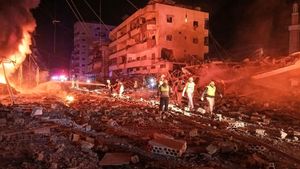Recently, Indonesia's Lewotobi Laki-laki volcano erupted, leaving communities reeling from tragedy and loss. The catastrophic event began on the night of November 3, 2024, which unfortunately resulted in the deaths of at least nine individuals. Among these was Sister Nikolin Padjo, who lived at the St. Gabriel monastery along with nearly 75 nuns and postulants. It was reported by Fr. Luigi Galvani, affiliated with the Camillian Mission, who highlighted the grim situation caused by falling debris during the unexpected eruption.
The situation quickly turned dire as rescue operations began. Fr. Galvani noted, “Rescue teams are currently searching for other victims who are believed to be trapped under the collapsed buildings.” The Lewotobi volcano, situated on Flores Island, lies strategically between the provinces of Larantuka and Maumere, and is part of the volatile volcanic region known as the “Ring of Fire.”
Local authorities have since mobilized military and police forces to help with evacuations. Heronimus Lamawuran, spokesperson for the East Flores regional government, explained the hurdles they faced during the urgent evacuation efforts. Many villages within the hazardous radius were dusted with thick volcanic ash, rendering access to some areas very complicated. “We plan to temporarily relocate residents until it’s safe for them to return to their villages,” Lamawuran stated definitively.
Approximately 16,086 residents from eight at-risk villages have been targeted for evacuation. Reports confirm around 2,472 individuals have been successfully relocated to temporary shelters, including schools and other safe facilities situated away from the volcano’s threat. Fr. Galvani emphasized the urgent need for aid: “Currently, the most requested aid is tents, food, drinking water, masks, medicines, and mattresses.” He remarked on the community’s solidarity, saying, “The race for solidarity seems to be alive, and we hope the Lewotobi volcano will soon find peace, allowing hundreds of families to return to their homes.”
Meanwhile, the Indonesian government declared a state of emergency lasting 58 days. This emergency response includes prohibiting activities within seven kilometers of the volcano's crater—an area deemed highly vulnerable. Following the main eruption, the volcano has remained on heightened alert, with smaller eruptions persisting.
The eruption at Lewotobi Laki-laki produced dramatic natural phenomena with ash plumes reported to have risen up to 12.2 kilometers (around 40,000 feet) and even ejected lava bombs as far as 4 kilometers (about 2.5 miles) from its summit. The increased seismic activity has prompted authorities to focus diligently on both evacuation and longer-term relocation plans for residents residing within the danger zone.
BNPB Chief Suharyanto stated, “The volcano cannot be moved, so it is the people who must move to safer locations.” He stressed the importance of long-term mitigation strategies, hinting at future dangers such as cold lava floods if the residents were to stay.
Right now, the government is still assessing the specific number of residents who will require permanent relocation. Emergency service teams are working hand-in-hand with local leaders to implement solutions—relocation could either be voluntary, allowing families to move instead to their own lands, or government-organized relocations to new housing arrangements, yet to be fully discussed.
The Lewotobi eruption tragically impacted migration patterns as it caused injuries to 63 individuals and substantial damage to around 2,384 homes and 25 schools. East Flores, which has witnessed the intensification of volcanic activity, now faces immense challenges as it navigates this disaster. According to Abdul Muhari, BNPB spokesperson, the devastation has compelled officials to enforce immediate emergency measures.
Geologically, Indonesia’s unique positioning along the Pacific “Ring of Fire” means it is no stranger to volcanic eruptions and seismic upheavals. The geology of the region is complex, with multiple tectonic plates constantly shifting, posing threats not only from eruptions but also from possible future lava floods from Lewotobi.
The societal ramifications of such significant geological events are enormous. Entire communities are uprooted as residents confront uncertain futures away from their ancestral lands. The evacuation marks not just physical dislocation but also emotional turmoil tied to losing homes, cultural ties, and safety nets.
Beyond the immediate logistical challenges posed, the recent eruption and the broader volcanic activity across Indonesia serve as reminders of the precarious nature of living within one of the world’s most tectonically active regions. Survivors must now look for ways to adapt and rebuild, with agencies like the Indonesian National Disaster Management Agency coordinating to provide immediate relief and long-term housing solutions.
The tragedy at Lewotobi Laki-laki has sparked discussions on preparedness and resilience against natural disasters, prompting authorities and communities alike to strategize on best practices going forward. Amidst the chaos, groups are mobilizing to offer psychological support and physical aid as the process of recovery begins—though the road to stability is undoubtedly rife with challenges. The dedication to restoring the displaced residents’ lives and building back their community will be watched closely as Indonesia continues to navigate its geographical vulnerabilities.



